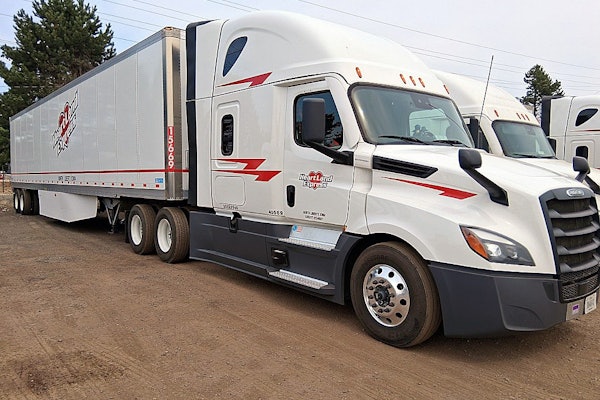Federal Motor Carrier Safety Administration had yet to announce its course of action regarding the hours-of-service regulations as CCJ went to press. The 45-day delay in the July 16 decision by the U.S. Court of Appeals for the District of Columbia vacating the current rules was to end Aug. 30. Options were to appeal the ruling or to initiate a rulemaking to replace the current rules. Either way, FMCSA could ask that the current rules remain in place in the interim.
FMCSA will conduct an extensive review of how the agency can best monitor truck and bus safety and ensure the compliance of operators. The multi-year Comprehensive Safety Analysis 2010 project begins this month with a series of public listening sessions. For a copy of the FMCSA notice, visit http://dms.dot.gov/search and search Docket No. 18898.
Penske Truck Leasing Co. will acquire the full-service truck leasing, rental, maintenance and logistics operations of Auto Rental Corporation, known as AMI Leasing, from Ford Motor Credit Co. The acquisition, covering more than 1,500 customers at 26 locations, adds about 14,000 tractors, trucks and trailers to Penske’s fleet.
Ohio Gov. Bob Taft has asked state officials to consider ending the split speed limit and reducing truck tolls on the Ohio Turnpike to entice more truckers to use the highway. Truck traffic on roads parallel to the turnpike has grown dramatically in recent years.
n National Motor Freight Traffic Association (www.nmfta.org) announced a new Weighing & Research (W&R) Training and Support Program to help motor carriers more accurately weigh, measure and classify freight. Estimates are that one in four shipments transported by common carriers are described, weighed or measured incorrectly, said Don Newell, who heads the W&R program for the organization.
ArvinMeritor named Charles McClure chairman, chief executive officer and president to replace Larry Yost, who retired. McClure most recently was CEO of Federal-Mogul and previously was present and CEO of Detroit Diesel.
California is poised to become the latest jurisdiction to regulate truck idling. On July 22, the California Air Resources Board approved a restriction that will limit truck and interstate bus operators to five minutes of nonessential idling, but allows for exceptions, according to a board announcement. The rule will become effective in about six months if it passes the California Office of Administrative Law’s technical review.
An important exception is that it will not apply to truck drivers who rest in sleepers in compliance with hours-of-service regulations. Those drivers would be exempt from the time limit but may be affected by future regulations. In general, the rule applies to any vehicle or combination of vehicles with a gross vehicle weight of more than 10,000 pounds. It applies to all trucks and interstate buses registered in California, as well as those from out of state. The Air Resources Board and California Highway Patrol would enforce the measure. The agencies could charge violators with a civil penalty of $100 per offense.
CARB stated the new rule is similar to its 2002 school bus idling regulation. Both the bus idling rule and the rule just adopted stipulate a five-minute idling maximum for all trucks and school buses within 100 feet of residences, even if the driver is sleeping.
The July 22 rule does not apply when idling:
*During certain traffic conditions, such as at a traffic light.
*While the vehicle is queuing, if it is at least 100 feet from residential areas.
*When forced to remain motionless because of bad weather or mechanical difficulties that the driver cannot control.
*When necessary to verify that all equipment is in good working order, such as during a daily inspection or when needed to test, service or diagnose a mechanical problem.
*While controlling cargo temperature; operating a lift, crane, pump, drill, hoist, mixer or other auxiliary equipment; or while providing mechanical extension to perform work functions for which the vehicle was designed.
*When operating defrosters, heaters, air conditioners or other equipment solely to prevent a safety or health emergency.
The regulation will cut 166 tons of particulate pollution per year and 5,200 tons per year of smog-forming nitrogen oxide emissions, the board says. California truck and bus operators are expected each to save an annual 125 gallons of diesel as a result of the regulation.
Board members removed a restriction that would have limited even trucks with sleeper berths and diesel-fueled auxiliary power systems to five minutes of idling, starting in 2009.
The California Trucking Association stated on its website that it had discussed the issue with CARB. “This left long-haul drivers with the option of finding a truck stop in order to plug in an on-board electrification system, renting a room and risk having their cargo stolen or braving the elements to sleep in the cab.” CARB agreed to work with the trucking industry on the issue.
Board Chairman Alan Lloyd said modern diesel engines and new, cleaner diesel result in truck engines that “do not have to be operated differently than other types of engines, which owners simply turn off when they are not in use.” For more information, visit this site.
TSA to test worker ID
Transportation Security Administration will begin a seven-month prototype phase of its Transportation Worker Identification Credential program. In the prototype, 150,000 workers in maritime, rail, aviation and ground transportation are expected to participate at more than 40 sites in six states. The test will be conducted in Camden, N.J.; Islip, N.Y.; Philadelphia; and Wilmington, Del. It also will be carried out in the ports of Los Angeles and Long Beach, Calif., and Florida’s 14 major ports. The nationwide, tamper-resistant card would incorporate “biometric” information based on biological characteristics, such as a fingerprint, that can be used for identification.
Volvo sees longer pre-buy with 2007 engines
While the peak of the pre-buy leading up to the introduction of the lower emission 2002 engines lasted two or three months, the pre-buy in anticipation of the 2007 engines will be more gradual, says Scott Kress, senior vice president, sales and marketing for Volvo Trucks North America. “Now, it’s two to three years,” he says.
Already demand for new trucks, much of it pent-up replacement demand, has Volvo running a five- to six-month backlog – despite increased capacity, Kress says. “But, we’re only going to take capacity so high as we’re facing ’07,” he says. He predicts that by the end of 2005, most truck makers could already be sold out for 2006.
That’s why Volvo, with others in the industry, champions proposed government incentives that would encourage immediate acceptance of the new engines and minimize a heavy pre-buy followed by a sharp drop in orders, as the industry experienced in 2002-2003. Volvo plans to have engines meeting 2007 emissions standards in the field for customer testing by 2005.
“We are trying to be as proactive as possible,” says Volvo Trucks North America President and CEO Peter Karlsten, who, with Kress, met with CCJ editors last month. “We would like to see it smooth out as much as possible.” For example, customers might agree to take only 70 percent of the trucks they need now and put off the other 30 percent into 2007, he says.
Even before demand for new trucks began picking up this year, Volvo’s market share increased by 2.8 percentage points to 10.3 percent since 2002, a bump Karlsten attributes to customers’ “excellent reception” of the new VN. “We don’t buy market share,” Karlsten says.
Volvo has grown its dealer network to 249 full-line and 105 parts and service locations, of which 130 offer both Mack and Volvo products. While the companies share an integrated back office, Volvo and Mack remain two distinct – even competing – companies, Karlsten says.
“Today, we have good geographical coverage – even in the West,” Karlsten says. However, the company does plan to grow its dealer network to around 400 over the next two to three years, primarily by adding dealerships west of the Mississippi.
– Linda Longton
Freightliner expects sales boom to continue
The Freightliner Group continues to outpace its long-term turnaround goals and expects the industry’s rebound to continue into at least 2006, said Rainer Schmueckle, president and chief executive officer.
Compared to the first half of 2003, Freightliner’s Class 8 truck orders are up 80 percent this year, Schmueckle told trade journalists in a July 30 conference call. Class 5-7 orders are up 45 percent.
He attributed the “sudden, enormous growth of orders” primarily to carriers replacing, but not expanding, their fleets. The purchases represent the conclusion of extended trade cycles, improvement in the economy and increasing comfort with the post-October 2002 engines.
Sales have been strong not only for the Freightliner brand, but also the group’s other truck brands, Western Star and Sterling. Dealer growth has been especially strong with the two smaller brands, Schmueckle said.
Another factor that will affect buying patterns in the next few years is the advent of 2007 engines that have to meet much tighter emissions requirements. Schmueckle said Freightliner, with others in the industry, continues to support proposed government incentives that would encourage immediate acceptance of the new engines and minimize the same pattern that happened in 2002-2003 – a heavy pre-buy followed by a sharp drop in orders.
Schmueckle said he expects to have Freightliner customers testing versions of the 2007 engines by the second half of 2005.
A more immediate element affecting sales is a scarcity of materials that is limiting production. For example, Caterpillar, Cummins and ArvinMeritor have announced allocation schedules in recent weeks, he said. Supplier shortages will affect production during the second half of 2004, but should begin to ease by early 2005. In spite of those production pressures, along with high fuel prices and the driver shortage, the industry should experience strong sales in 2005 and 2006, he said.
Used trucks, too, are being snapped up. “For the first time, we’ve reduced inventories to close to the 10,000-unit mark, which is where we want the used truck availability to be,” Schmueckle said. In 2001, that figure was “far in excess of 20,000 units,” he said.
That year Freightliner announced a restructuring plan by which it intended to break even by 2003 and reach at least a 13 percent return on net assets by 2004.
“The fact is, we have accomplished much more,” Schmueckle said. The break-even point was reached in 2002 and the return for 2004 should be close to 20 percent.
–Max Heine
TCA to pick top drivers, contractors
Truckload Carriers Association has begun accepting applications for its Company Equipment Driver of the Year and Independent Contractor of the Year contests.
The Independent Contractor contest is sponsored by TCA and Overdrive, a sister magazine to CCJ. It recognizes owner-operators for business skills, safety and their efforts to enhance the image of trucking. Among the prizes for the winner is a new International tractor.
The Company Driver contest, sponsored by TCA and Truckers News, another sister of CCJ, honors drivers who stand out in safety, work history and past awards and recognition. The five winners of each contest will be announced during TCA’s annual meeting March 6-9 in Las Vegas. The top winners in both contests receive cash and trucking merchandise from sponsors.
The deadline to apply is Oct. 22. Finalists will be notified by Oct. 31 and asked to submit a more detailed application by Dec. 17. The application form is available at this site.
The contests are open to all over-the-road truckload drivers who have driven at least 1 million consecutive accident-free miles. A driver who has won the grand prize in either contest before is not eligible to enter the contest again. A driver who has been a second- or third-place winner is not eligible to apply again for two years from the date of winning.
ATA endorses J.J. Keller simulator
American Trucking Associations has endorsed the SAFE-Sim Truck Driving Simulator, a PC-based driver-training simulator developed by J. J. Keller & Associates. SAFE-Sim simulates a variety of high-risk or emergency situations, including aggressive motorists, vehicles running stop signs, pedestrians running into the street, heavy fog and more. The system simulates about 750 miles of actual roads based on U.S. geological survey maps.
The simulator focuses on specific driving skills, including hazard perception, defensive driving, situational awareness, speed and space management, mirror use, cornering, backing, emergency maneuvers, skid control/recovery and crash avoidance. SAFE-Sim’s Trip Report allows the trainer to identify areas for driver improvement.
J.J. Keller offers a 30-day test drive of SAFE-Sim for $149. For more information, visit this site.
Environmental Briefs
Department of Energy’s Oak Ridge National Laboratory and the University of Tennessee are conducting a study of the health effects on truck drivers of exposure to engine emissions while idling, especially at truck stops. Several U.S. government agencies are funding the study.
EPA is seeking public comment by Oct. 9 on the development of uniform national standards for truck stop electrification infrastructure to eliminate long-duration truck idling. The notice appeared in the July 8 Federal Register.
Minnesota carriers Lakeville Motor Express, McFarland Truck Lines, R&E Enterprises of Mankato and Transport America have joined the SmartWay Transport Partnership, an Environmental Protection Agency program that tries to encourage carriers and shippers to be environment-friendly. Visit this site.
FMCSA to target outlaw truckers
Within the next year, interstate truckers who try to escape regulatory scrutiny and insurance responsibilities by operating without motor carrier authority could discover that their efforts are inadequate. The Federal Motor Carrier Safety Administration is considering a “non-entrant” inspection program that would try to ferret out outlaw operators, Charles Horan, director of FMCSA’s office of enforcement and compliance, said last month.
The initiative is still in development, but the agency likely would work with state and local law enforcement as well as equipment and service suppliers. Horan discussed the planned effort in comments to a meeting in Toledo, Ohio, of the Highway Committee of the National Industrial Transportation League, which represents shippers.
Horan said the program was a brainchild of FMCSA Deputy Administrator Warren Hoemann, who is concerned that virtually all of FMCSA’s efforts are aimed at carriers that have Department of Transportation numbers. Hoemann believes a significant number of unregistered truck operators are in greatest need of safety oversight, Horan says. “We want to … get unsafe guys off the road,” he added.
Get recognition for your fleet graphics
The National Private Truck Council and Commercial Carrier Journal invite entries in the 2004 Commercial Fleet Graphics Awards, which will be announced at NPTC’s annual conference in Pittsburgh next April. The entry deadline is Dec. 31, 2004.
The contest is open to all fleets – private and for-hire, owned or leased – of trucks, tractor-trailers, buses or mixed vehicles. Automobiles and one-of-a-kind designs, such as show trucks or racing-car transporters, are not eligible. Graphics designed for daytime and nighttime visibility are judged separately. Photographs of winning entries will be featured in CCJ.
Each entry must include either color prints (5-by-7 permitted; 8-by-10 preferred) or high-resolution (300 dpi or better) digital images in JPEG or TIF format. Photos must clearly depict the front, side and rear views of the vehicle. There is no limit on the number of photos that may be submitted. Digital images can be submitted by CD-ROM or by e-mail. E-mail submissions must be confirmed by a completed entry form transmitted by fax to (205) 750-8070.
Entry forms are available under “CCJ Special Info” to your left or by contacting Dean Smallwood at (800) 633-5953, ext. 1039; [email protected].









